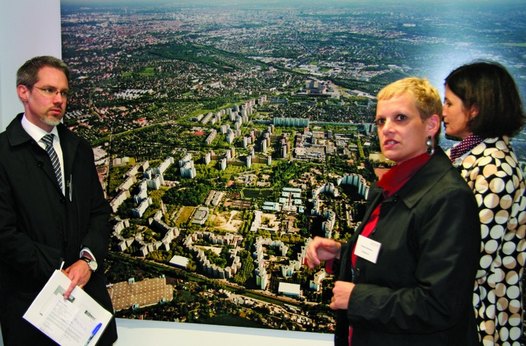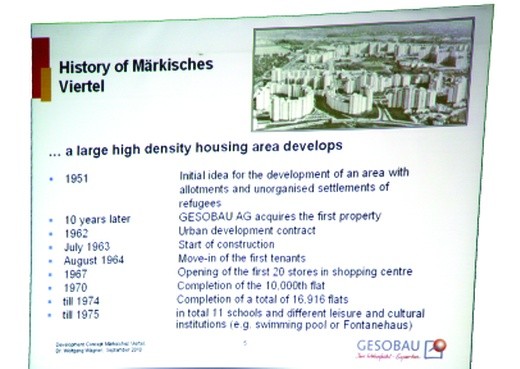
Dr. Wolfgang Wagner (left) and Kristen Huthman from GESBAU Public Relation presents the future of Märkishes Viertel. Photo: Odd Iglebaek
However, insulation was poor and heating has grown very expensive. Much of the infrastructure has become outdated, the buildings have not been properly maintained and, in general, the area gives the impression of being worn and run down. The entire area is however currently undergoing a major process of renovation.
"One aim is to reduce energy consumption by approximately 50%", explains Wolfgang Wagner. Wagner is head of portfolio management at GESOBAU. The housing company, which is owned by the municipality of Berlin, owns 15 000 flats in the area and put in place a major plan to modernise 13 000 flats in 2007. Märkisches Viertel was originally designed to house some 40 000 people in 17 000 flats. The flats are for rent.
"Before we started energy consumption was calculated at 174 kWh per m2 annually. We hope to get this down to between 70 and 80 kwh per m2. We hope to do this through a mixture of means such as new windows, better insulation and, new heating systems - as well as introducing individual control of not only electricity but also heating in each flat."
"People will be able to see how much energy they are consuming, and on what, and pay accordingly. It is no longer seen as appropriate to regulate heat from radiators by opening windows. In short we want to show that large residential developments are also environmentally viable for the future", he adds.
 Social housing
Social housing
Märkisches Viertel was built as an experiment in social housing. One important element in this was loans subsidised by the government. Already some years ago GESOBAU decided to leave this system behind and instead borrow on the private market. – "In fact, it is cheaper both for us as a company and the residents, since the conditions for the loans are better", explains Wagner.
"Berlin has some 100 000 empty flats and before we started improving Märkisches Viertel our vacancy rate was usually 10-12%. We aim to get this down to 3-4%. This, combined with cheaper loans, indicates that we will manage to maintain the rent at a stable level. At present this is 7.81 euros per m2 per month, including heating."
The scheme has some 1 000 different floor plans and the size of flats varies from 40m2 one-room units to 110m2 five-room units. Single-person households comprise 37% of all households, 36% are two-person units, 12% three-person units and 15% four or more person units. The ratio of small households has increased significantly and the number of people living here has been reduced to 36 200, or by around 10% during Märkisches Viertel's two-generation lifespan.
Another major change is that the number of people living on social benefits, or transfer income as it is called in Germany, has been rapidly declining among newcomers to Märkisches Viertel. "For people now moving here it is around 10% or approximately half of what it used to be", says Wolfgang Wagner. For Berlin as a whole the figure is also 20%.
Originally the houses had garbage chutes. Due to the fire-risk this caused however they were closed when the houses were refurbished. Today the garbage is collected from containers on the ground-floor level. There are bins in the vicinity of each house for recyclable materials like plastics, paper and glass.
The renovation-scheme does not have any particular policy with regard to cars. At present there is one parking space for each flat. The renovation of Märkisches Viertel commenced in 2008 and the plan is for it to be concluded by 2015. The total cost is estimated at 480 million euros.

Renovated high-rise housing in Märkishes Viertel. Photo: Odd Iglebaek
By Odd Iglebaek